Numerics
- 2-connected graph
-
Also known as a biconnected graph: A connected graph that will remain a connected graph if any one node is removed. (In other words, a graph in which at least two distinct paths exist between every two nodes.) A 2-connected graph has no cut-edge or cut-node.

A
- acyclic graph
-
A graph that has no cycles.
- annealing
-
See simulated annealing .
- aspect ratio
-
The ratio between a width and a height. A square has an aspect ratio of 1.
- automatic layout
-
A layout process where the layout algorithm does everything without any user intervention.
B
- biconnected graph
-
See 2-connected graph.
- branch
-
A subpart of a tree that is itself a tree.
- bus topology
-
A type of network topology where a set of nodes is connected to a bus object.
C
- child node
-
A node connected to the current node that is farther way from the root node. In a tree, all links incident to a parent node end at child nodes, except one, which ends at the parent node's parent node.
- cluster
- connected component
-
A connected graph or subgraph. A connected component of a flat graph G is a maximal connected subgraph of G.
- connected graph
-
A graph where there is a path connecting each pair of nodes. See also disconnected graph.
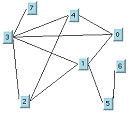
- connection
-
Another name for an edge of a graph. See also edge.
- constraint
-
A specification that limits the area where objects can be placed. For example, there can be a constraint that one object must be placed to the left of another object.
- cut-edge
-
An edge is a cut-edge if the graph is no longer connected when the edge is removed from the graph. In the following graph, the link between nodes 3 and 5 is a cut-edge. Note that its end points are cut-nodes.
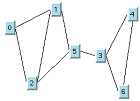
- cut-node
-
A node is a cut-node if the graph is no longer connected when the node is removed from the graph. In the following graph, node 5 is a cut-node.
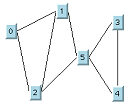
- cycle
-
A path of a graph that begins and ends on the same node. Also called a loop.
- cyclic graph
-
A graph that contains cycles.
- cyclomatic number
-
A number equal to m - n + 1, where m = number of edges and n = number of nodes. In the following illustration, the number of edges = 10, the number of nodes = 8. Therefore, the cyclomatic number is 10 - 8 + 1 = 3.
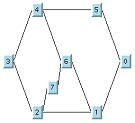
D
- degree
-
The degree of a node v of a graph G is the number of graph edges which touch v.
- directed graph
-
A graph in which every edge is associated with an ordered pair of nodes. Also called an oriented graph. See also directed link.
- directed link
-
A link with a direction that starts at one of its incident nodes and ends at the other incident node. Directed links are usually drawn with arrowheads that indicate the direction. In a mathematical sense, a directed link is an ordered pair of nodes, while an undirected link is an unordered pair of nodes. See also directed graph.
- disconnected graph
-
A graph containing at least two nodes that are not linked by a path. In the following graph, node 5 is not linked by a path to any other node. Nodes 3 and 4 are not linked by a path to any nodes other than nodes 3 and 4.

E
- edge
-
A line connecting two vertices in a graph. An edge is also called a link or a connection. In this documentation, the term link is primarily used for the term edge.
- edge crossing
-
See link crossing.
F
- fixed link
-
A link which remains in the same position during graph layout or link layout. If the user specifies a link as fixed, layout algorithms are not allowed to reshape this link.
- fixed node
-
A node which remains in the same position during graph layout or link layout. If the user specifies a node as fixed, layout algorithms are not allowed to move this node.
- flat graph
-
The converse of a nested graph: a graph of which no node is itself a graph. See nested graph.
- Force-directed layout
-
A class of layout algorithms for creating straight-line drawings of undirected graphs based on an iterative computation of the position of the nodes according to a set of attractive and repulsive forces. These forces are computed in such a way that they tend to produce a layout with only a few link crossings or no link crossings.
G
- graph
-
A finite set of nodes (also called vertices) connected by a finite set of links (also called edges or connections).
- graph layout
-
The process that applies a layout algorithm to a graph. Also the graph drawing that results from the layout process.
- graph model
-
In the context of graph layout, a Java™ class that defines a suitable, generic API for graphs.
- grapher
-
A Java™ object that is used to manage a collection of nodes and links.
- grid drawing
-
A drawing where nodes and link bends have discrete (integer) coordinates.
I
- incident
-
A link-node connection. A link is incident to a node if the node is at one end of the link. A node is incident to a link if that link is incident to the node.
- incoming link
-
A directed link that ends at the node.
- incremental layout
-
A layout process where the result of a previous layout is used as the starting point for applying the layout algorithm a second time to a modified graph in order to minimize the changes.
- intercluster link
-
A link that has its end nodes in different clusters.
- intergraph link
-
In a nested graph, a link whose end nodes are contained in different subgraphs.
- intracluster link
-
A link that has its end nodes in the same cluster.
L
- layout algorithm
-
The process that computes new coordinates for nodes and/or new shapes for links in order to obtain a suitable representation of a graph.
- layout region
-
In the context of graph layout, the rectangle where the graph drawing will be placed when the graph is laid out.
- leaf
-
A node in a tree that is not the root and has at the most one incident edge; that is to say, a node that has no child nodes. The nodes of the tree are named root (one special node), leaves, and inner nodes (all nodes that are not root or leaves).
- leaf recursive tree
-
A nested graph that is a tree and only the leaves of the tree can be subgraphs.
- link
-
Another name for an edge in a graph. In this documentation, the term link is primarily used for edge. See also edge.
- link bundle
-
A set of links (edges) connecting a given pair of nodes in a graph, drawn as a set of parallel lines. See multiple links.
- link crossing
-
Link crossings occur when links intersect at places other than an incident node. Also called edge crossings. Often, layout algorithms are used to minimize the number of link crossings.
M
- multiple links
-
More than one link between the same origin and destination nodes.
N
- neighbor nodes
-
The nodes that are connected to a given node by a link.
- nested graph
-
A graph that contains nodes that are graphs, that is, a graph that contains nested subgraphs.
- node
-
Another name for a vertex of a graph. In this documentation, the term node is primarily used for vertex.
- nonplanar graph
-
A graph that cannot be drawn without any links crossing other links.

- NP-complete
-
A class of computational problems for which no efficient solution algorithm has been found. Many significant computer science problems, including many graph layout problems, belong to this class.
O
- orthogonal drawing
-
A drawing where each link is drawn as a polygonal chain of alternating horizontal and vertical segments.
- outgoing link
-
A directed link that starts at the node.
P
- parent node
-
A node connected to the current node that is closer to the root node. In a tree, all links incident to a parent node end at child nodes, except one that ends at the parent node's parent node.
- path
-
A sequence of consecutive nodes leading from one node to another using the links of the graph. It is the route along the links through the nodes in a graph. The length of a path is the number of links traversed.
- planar graph
-
A graph that can be drawn with no links crossing other links.
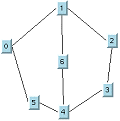
- polyline drawing
-
A drawing where each link is drawn as a polygonal chain.
- preferred layout
-
In the context of Recursive Layout, the layout instance set as the one to be used for each graph. It is stored in a property of the graph.
R
- radial drawing
-
A layout style where the nodes are placed radially around a root node.
- recursive
-
The fact that the same mechanism that is applied to a large structure is also applied to its substructures. A recursive layout that is applied to a nested graph is also applied to each subgraph.
- ring
-
A type of network topology where the nodes are arranged in a circular configuration.

- root
-
In a tree, the root is only one specified node. In a directed graph, a root is a node that has no incoming links.
S
- seed value
-
The value that is used for the initialization of a random number generator. Some layout algorithms use random numbers during the layout computation.
- self-link
-
A link whose origin and destination nodes are the same node.
- semiautomatic layout
-
A layout process where the user makes manual improvements to the result of the automatic layout process.
- sibling node
-
Child nodes that have the same parent node are called sibling nodes.
- simulated annealing
-
A mathematical technique assisted by a temperature scheme to find a good approximation of the optimum with respect to a certain goal. Simulated annealing was originally inspired by the physical effect of steel annealing when steel is heated and cooled down slowly. In graph layout, simulated annealing is used to place labels in such a way that they do not overlap with one another or with nodes and links.
- spanning tree
-
A minimal subgraph, defined as follows: A spanning tree S of a flat graph G is a subgraph of G containing all the nodes of the graph and whose links are a subset of the links of the graph. The number of links of G that are not present in S must be the minimum number for which there are no cycles in S. The spanning tree is shown by the red links in the following illustration.

- spline
-
One possible appearance of a link connecting nodes: it is a smooth curve governed by control points.
- star
-
A type of network topology where the nodes are arranged on a circle with each node being connected to a center node.

- straight-line
-
Denotes a drawing where each link is drawn as a straight line segment.
- subgraph
-
A graph that is contained in another graph. In flat graphs, G' is a subgraph of G if its node and link sets are included in the node and link sets of G.In nested graphs, a node that is a graph is called a subgraph of the nested graph.
T
- tip-over
-
A placement strategy for trees where child nodes are alternately arranged horizontally or vertically.
- topology
-
The structure of a graph. Two drawn graphs have the same topology if you can obtain one drawing from the other by moving the nodes and reshaping the links.
- tree
-
An undirected tree is a connected undirected acyclic graph (that is, a graph that does not contain any cycles). A directed tree is a connected directed graph where each node has exactly one incoming link except the root node, which has no incoming links.
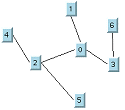
U
- undirected graph
-
A graph in which every link is associated with an unordered pair of nodes. See also undirected link.
- undirected link
-
A link that has no specific direction. Contrary to directed links, undirected links have no ordering between both incident nodes. In a mathematical sense, a directed link is an ordered pair of nodes; an undirected link is an unordered pair of nodes. See also directed link and undirected graph.
V
- vertex
-
An element of the graph that can be connected by edges. A vertex is also called a node. In this documentation, the term node is primarily used for the term vertex. A graph consists of a finite set of vertices connected by a finite set of edges (also called links or connections). In drawings, vertices are often displayed as boxes and edges are often displayed as lines.